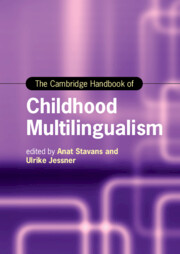Book contents
- The Cambridge Handbook of Childhood Multilingualism
- Cambridge Handbooks in Language and Linguistics
- The Cambridge Handbook of Childhood Multilingualism
- Copyright page
- Contents
- Figures
- Tables
- About the Editors
- Contributors
- Acknowledgments
- Multilingualism Is Not Bilingualism +1: An Introduction
- Part One Becoming and Being a Multilingual Child
- Part Two Cognition and Faculties in Multilinguals
- Part Three Family Language Policy
- Part Four Language(s) and Literacy of Multilingual Children through Schooling
- Part Five Socialization in Childhood Multilingualism
- 21 Building a Plurilingual Identity
- 22 Multilingual Parenting in the United States: Language, Culture and Emotion
- 23 The Development of the Heritage Language in Childhood Bi-/Multilingualism
- 24 Social Cohesion and Childhood Multilingualism in South Africa
- 25 Growing Up in Multilingual Societies: Violations of Linguistic Human Rights in Education
- Part Six Multilingual Children’s Landscape
- Subject Index
- Country Index
- Language Index
- References
21 - Building a Plurilingual Identity
from Part Five - Socialization in Childhood Multilingualism
Published online by Cambridge University Press: 18 August 2022
- The Cambridge Handbook of Childhood Multilingualism
- Cambridge Handbooks in Language and Linguistics
- The Cambridge Handbook of Childhood Multilingualism
- Copyright page
- Contents
- Figures
- Tables
- About the Editors
- Contributors
- Acknowledgments
- Multilingualism Is Not Bilingualism +1: An Introduction
- Part One Becoming and Being a Multilingual Child
- Part Two Cognition and Faculties in Multilinguals
- Part Three Family Language Policy
- Part Four Language(s) and Literacy of Multilingual Children through Schooling
- Part Five Socialization in Childhood Multilingualism
- 21 Building a Plurilingual Identity
- 22 Multilingual Parenting in the United States: Language, Culture and Emotion
- 23 The Development of the Heritage Language in Childhood Bi-/Multilingualism
- 24 Social Cohesion and Childhood Multilingualism in South Africa
- 25 Growing Up in Multilingual Societies: Violations of Linguistic Human Rights in Education
- Part Six Multilingual Children’s Landscape
- Subject Index
- Country Index
- Language Index
- References
Summary
In an increasing number of families and communities, children grow up in multilingual and multicultural environments. Children thus negotiate their identities while navigating across linguistic practices and ideologies at home, in school, and in community spaces. This paper has two main aims. First, it develops a clearer understanding of developments in the research domain of plurilingualism, identity, childhood and education. Second, it provides insight into the nexus between children’s’ identity construction and larger societal discourses and practices. In the first part, the focus lies on the concept of identity itself and the way it relates to language(s), discourse(s) and societal language ideologies. In the second part, the focus is on some contexts that are especially relevant for the development of children’s linguistic identities and agency, such as family language policies, early childhood education in nurseries, language regimes and pedagogical traditions of language teaching in schools. The important role of educational institutions with regard to the lingua-cultural identity development of children and adolescents in a globalized world becomes more than evident.
- Type
- Chapter
- Information
- The Cambridge Handbook of Childhood Multilingualism , pp. 491 - 514Publisher: Cambridge University PressPrint publication year: 2022



